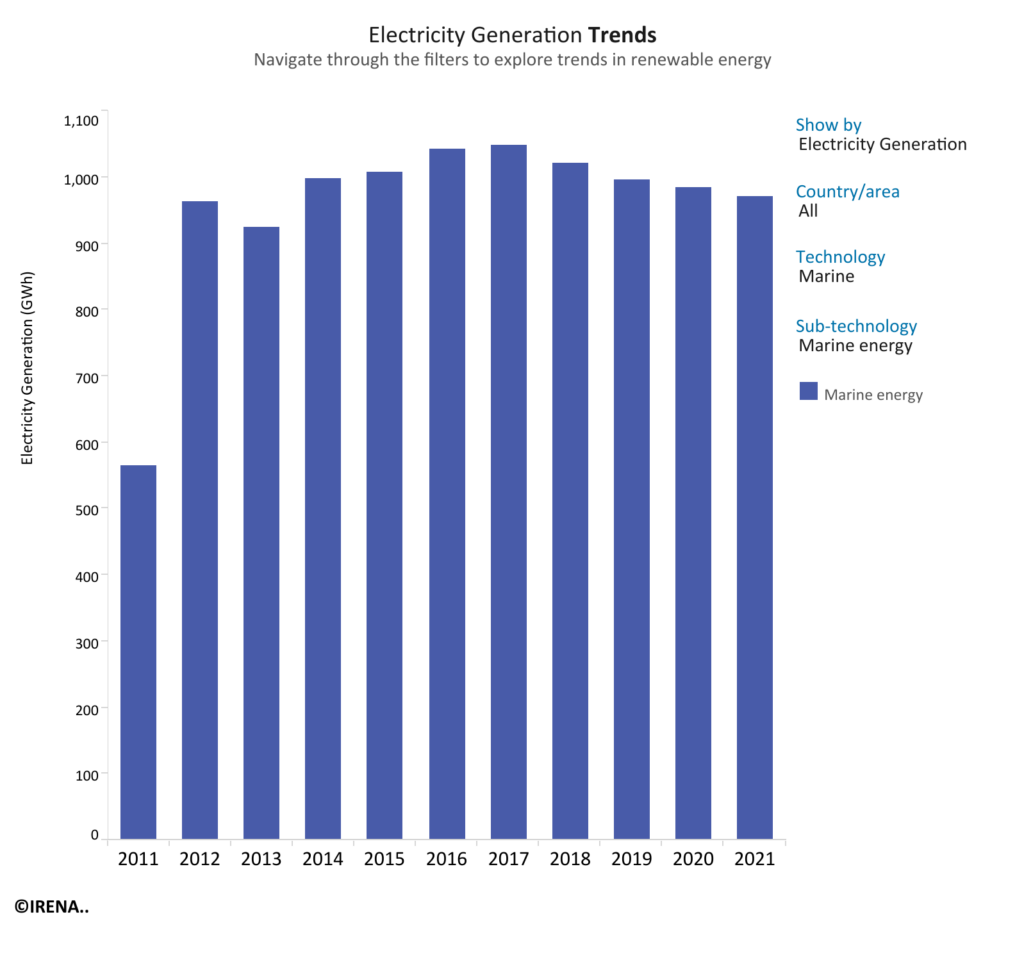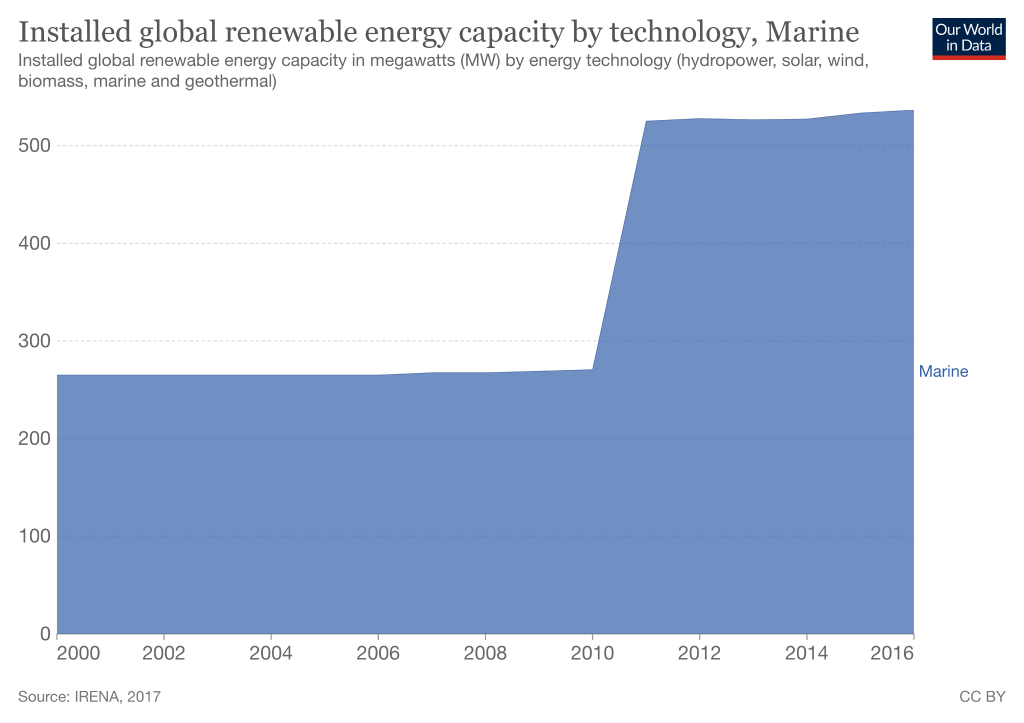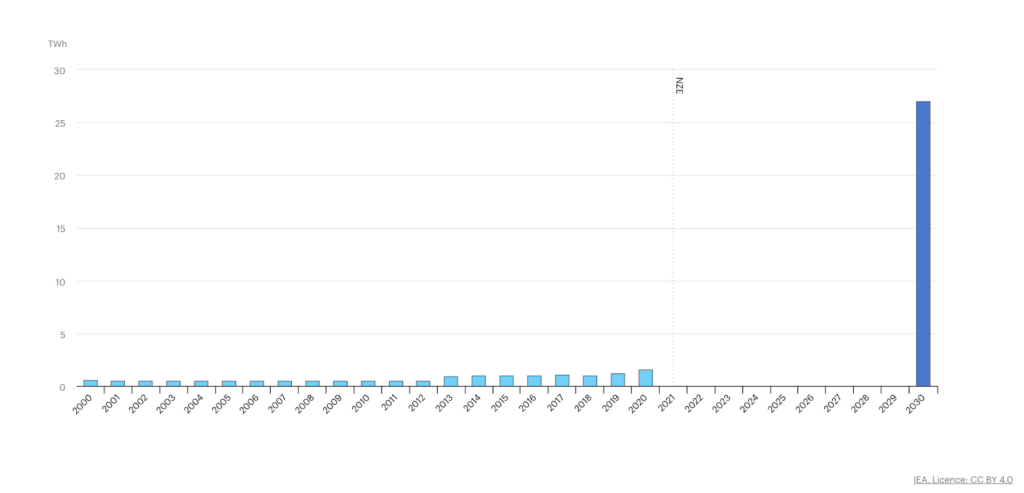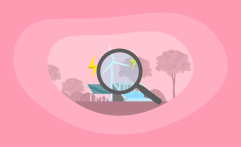The History of Tidal Energy: The Big Picture
Impactful Ninja is reader-supported. When you buy through links on our site, we may earn an affiliate commission.
Learn more
Learn more
.
Hey fellow impactful ninja ? You may have noticed that Impactful Ninja is all about providing helpful information to make a positive impact on the world and society. And that we love to link back to where we found all the information for each of our posts. Most of these links are informational-based for you to check out their primary sources with one click. But some of these links are so-called "affiliate links" to products that we recommend. First and foremost, because we believe that they add value to you. For example, when we wrote a post about the environmental impact of long showers, we came across an EPA recommendation to use WaterSense showerheads. So we linked to where you can find them. Or, for many of our posts, we also link to our favorite books on that topic so that you can get a much more holistic overview than one single blog post could provide. And when there is an affiliate program for these products, we sign up for it. For example, as Amazon Associates, we earn from qualifying purchases. First, and most importantly, we still only recommend products that we believe add value for you. When you buy something through one of our affiliate links, we may earn a small commission - but at no additional costs to you. And when you buy something through a link that is not an affiliate link, we won’t receive any commission but we’ll still be happy to have helped you. When we find products that we believe add value to you and the seller has an affiliate program, we sign up for it. When you buy something through one of our affiliate links, we may earn a small commission (at no extra costs to you). And at this point in time, all money is reinvested in sharing the most helpful content with you. This includes all operating costs for running this site and the content creation itself. You may have noticed by the way Impactful Ninja is operated that money is not the driving factor behind it. It is a passion project of mine and I love to share helpful information with you to make a positive impact on the world and society. However, it's a project in that I invest a lot of time and also quite some money. Eventually, my dream is to one day turn this passion project into my full-time job and provide even more helpful information. But that's still a long time to go. Stay impactful,Affiliate Disclosure
Why do we add these product links?
What do these affiliate links mean for you?
What do these affiliate links mean for us?
What does this mean for me personally?
![]()
The kinetic energy stored in tides represents a vast, and thus far, relatively untapped reservoir of power that could help us transition away from fossil fuels and towards a more sustainable future. So, we had to ask: What is the history of tidal energy?
Tidal energy began in 1920 with the idea to harness power from tides. Then, the construction of the first tidal power facility in 1966 spurred research into commercial viability. Tidal has yet to establish itself as a part of the mainstream energy industry due to financial and geographical barriers.
One way to combat the current global climate crisis threatening Earth’s environmental, economic, and social health is to transition away from traditional fossil fuels and toward cleaner energy sources, such as tidal energy. Keep reading to learn how tidal energy came to be, who and what pioneered its development, how effective it has been thus far, and what the future of tidal energy could entail.
Here’s the History of Tidal Energy in a Nutshell
Tidal energy is defined as the conversion of the movement of ocean water volumes into electrical energy through the use of various tidal systems.
“Tidal Power: power that comes from the movement of the tide (= the rise and fall of the ocean that happens twice every day) and that can be used especially for producing electricity”
Cambridge Dictionary
Tidal energy is potential energy created by tides, height changes in sea level that are caused by the gravitational pull of the sun and moon coupled with the rotation of the earth.
Marine energy refers to both tidal and wave energy. Tidal energy is often referred to as marine energy in the literature and data.
Tidal energy has gone through three distinct development phases in its development:
- Early market formation and innovation: The early history of tidal energy dates back to the 7th century with the use of tide mills to primarily grind grain.
- Consolidation and strengthening: The construction of the world’s first tidal barrage system kickstarted the tidal energy movement. Since then, the industry has seen slow progression due to high costs and the potential for negative impacts on aquatic wildlife.
- Mainstreaming: Tidal energy has yet to establish itself as a part of the mainstream energy industry, with the focus still remaining heavily on research and development.
| Tidal Energy Milestones | Historical Event |
| Initial start | The early history of tidal energy dates back centuries, beginning in the 7th century with the use of tide mills to primarily grind grain. |
| Milestones in tidal energy development | 1920: Dexter Cooper came up with the idea of harnessing power from tides. 1924: The US Federal Power Commission carried out a study to determine the viability of installing tidal power plants in Maine and New Brunswick. 1956: Nova Scotia Light and Power (NSLP) carried out two studies to determine the viability of installing tidal power in the Bay of Fundy, Canada. 1966: The La Rance Tidal Power Station was opened in France, the first tidal power plant in the world. 1984: The Annapolis Tidal Power Plant was opened in Canada, the first tidal power plant in North America. 2007: The world’s first tidal turbine system was constructed at Strangford Lough in Northern Ireland. 2011: The Sihwa Lake Tidal Power Station, the largest operational tidal power plant in the world, was opened in South Korea. 2018: Construction began on The MeyGen Tidal Energy Project, which will be the largest tidal power facility in the world. |
| Current status | Currently, we generate roughly 970 gigawatt hours (GWh) of electricity from marine energy (tidal + wave energy). Tidal energy is still a relatively new and understudied technology, with more investments and research needed. |
| Future outlook | The future of tidal energy will be heavily influenced by further research and investments, which have been limited thus far by financial and geographical barriers. |
| Key policy developments | 1974: International Energy Agency (IEA) 2001: Ocean Energy Systems (OES) 2009: The International Renewable Energy Agency (IRENA) 2013: Ocean Energy Europe (OEE) 2015: Paris Climate Agreement |
Understanding tidal energy’s history can provide insight into how it has evolved into the energy source it is today.
When and How Did Tidal Energy Get Started
The early history of tidal energy dates back centuries, beginning in the 600s with the use of tide mills. Tide mills are water mills driven by the rise and fall of tides. They consisted of a storage pond that filled up as the tide came in and emptied as the tide went out. This ebb and flow of water rotated a water wheel to generate power which was used to grind grain.
Tide mills grew in popularity throughout the Middle Ages, and hundreds were in operation around the shores of the Atlantic Ocean by the 1800s.
How Has Tidal Energy Developed Over Time
Tidal energy is still a relatively new and understudied technology. Pending significant research and development, it could play an important role in the global energy transformation.
What Are Milestones in Tidal Energy Development
The tidal energy market began to develop in the 1960s following the opening of the world’s first tidal power plant.
1920: Engineer Dexter Cooper came up with the idea of harnessing power from tides. He had plans to implement his ideas at Cobscook and Passamaquoddy bays in Maine (US).
1924: The US Federal Power Commission carried out a study to determine the viability of tidal power in Maine (US) and New Brunswick (Canada). The stock market crash of 1929 eventually shut down the project due to a lack of funding.
1956: Nova Scotia Light and Power (NSLP) carried out two studies to determine the viability of tidal power in the Bay of Fundy (Canada). Cost again was the main issue, despite the potential to generate a substantial amount of electricity.
1966: The La Rance Tidal Power Station was opened in France. The tidal barrage system is located on the estuary of the Rance River and has a 240-megawatt (MW) installed capacity. La Rance is also the oldest and second-largest operational tidal power plant in the world.
1984: The Annapolis Tidal Power Plant was opened in Canada, becoming the first tidal power plant in North America. The tidal barrage system is located in the Bay of Fundy and has a 20 MW installed capacity.
2007: The world’s first tidal turbine system was constructed at Strangford Lough in Northern Ireland. The tidal turbines were placed in the strait between the Strangford Lough inlet and the Irish Sea, where the tide moves at approximately 4 meters (13 feet) per second.
2011: The Sihwa Lake Tidal Power Station was opened in South Korea. The tidal barrage system is the largest operational tidal power plant in the world with an installed capacity of 254 MW. It also has a 12.5-kilometer (7.8-foot) sea wall for flood mitigation and agricultural purposes.
2018: Construction began on The MeyGen Tidal Energy Project, which will be the largest tidal power facility in the world once completed with an output of 400 MW.
How Has the Tidal Energy Market Developed Recently
Recent years have seen marine energy remain stagnant both in terms of installed capacity and investment. With very few countries currently generating or installing tidal power, the focus remains on refining the technology and increasing investments for future commercial energy generation.
What Is the Present Status of Tidal Energy
Globally, we generated 970 gigawatt-hours (GWh) of electricity in 2022, from marine energy (tidal + wave energy), a slight decrease from the previous year.

The global installed capacity of ocean technology (tidal + wave energy) has remained relatively stable over recent years but has increased from 238 to 524 MW between 2000 and 2022.

Although tidal and wave energy capacity has more than doubled over the past 20 years, its development worldwide has been disproportionate.
The 6 countries leading the world in terms of installed tidal energy capacity (in megawatts (MW)) are:
- South Korea – 511 MW
- France – 246 MW
- United Kingdom – 139 MW
- Canada – 40 MW
- Belgium – 20 MW
- China – 12 MW
Only a few countries currently harness and produce tidal and wave energy while the rest produce little to none. This can be partly explained by the geographical needs of tidal energy, which include a strong flow of water.
How Will the Future of Tidal Energy Look Like
The future of tidal energy will be heavily influenced by further research and investments, which have been limited thus far by financial and geographical barriers.
How Tidal Energy Will Likely Develop in the Future
Overall, the IEA has labeled marine energy (tidal + wave energy) as ‘more efforts needed’ in their Net Zero Emissions by 2050 Scenario in terms of capacity and investments.
Marine energy power generation would need to increase by 1 gigawatt (GW) per year from 2023-2030, but this is not expected to be achieved given the current lack of research and investments.

The global marine energy market is predicted to increase by over 20% to be worth $1.54 billion by 2030. But this will heavily depend on whether we can overcome marine energy’s main obstacles: cost, geography, and sea level rise.
- Cost: A 2019 study found tidal energy to cost between $130-$280 per megawatt-hour (MWh) of electricity, compared to only $20 per MWh for wind energy. The costs associated with building tidal facilities, maintaining machinery, and protecting equipment from corrosive saltwater have led to a large discrepancy between the cost of tidal energy compared to other renewable energy systems (e.g., solar, wind, hydropower).
- Geography: The other main obstacle to tidal power involves geographical limitations. Tidal energy can only be installed on coastlines, but not all coastlines suit tidal power plants. In addition, a basin’s width, length, and shape, river inflows, and the height of the sea are all site-determining factors.
- Sea level rise: This could throw a wrench in the world’s tidal energy plans, because rising sea levels can displace, eliminate, or even create new sites. And because tidal technology is designed to last for decades, planning future projects must take sea level rise into account.
Despite these barriers, some countries have recognized the great potential of tidal energy. For example, The MeyGen Tidal Energy Project, located off the northern coast of Scotland, will be the largest tidal power facility in the world (400 MW capacity) once completed. As of March 2023, MeyGen has generated roughly 51 GWh of electricity from phase 1 of 4 of the project’s development.
Tidal energy has the potential to play a key role in the renewable energy movement:
- Tidal energy has a low carbon footprint: Estimates for the life-cycle global warming emission of tidal energy are below 0.05 pounds (22 grams) of carbon dioxide equivalent per kilowatt-hour (gCO2 per KWh). This is a fraction of the emissions of coal power plants, which produce an estimated 820 gCO2 per KWh.
- Tidal energy is predictable and stable: Unlike other renewable energies (solar and wind), marine energy is available for use 365 days a year. Tides are easy to forecast and rarely experience significant variations in timing.
- Tidal energy is a concentrated energy source: Water contains approximately 1,000 times the kinetic energy of wind, therefore tides can produce the same amount of energy with less material. Experts estimate tidal energy could produce between 150 and 800 terawatt hours of renewable energy per year, more than Canada’s energy production in 2019.
- Tidal energy has a low land use requirement: The largest tidal facility in the world spans 12.7 kilometers, compared to wind and solar energy systems which can take up hundreds of kilometers of land for wind turbine or solar panel farms.
What Policies Are Put in Place to Support Tidal Energy Usage
The most well-known piece of legally binding, international climate mitigation legislation is The Paris Agreement, the goal of which is to limit global warming to below 2 degrees Celsius (C), preferably to 1.5C, compared to pre-industrial levels.
The Paris Agreement specifically notes a transition towards renewable energies, such as tidal energy, as being a critical part of meeting these goals.
Check out the highlights of the 2015 COP21 directly from the UN Climate Change channel:
In addition, The International Energy Agency’s (IEA) Net Zero Emissions by 2050 Scenario is one framework for the global energy sector to achieve net zero CO2 emissions by 2050 and universal energy access by 2030.
There are many global tidal energy policies and organizations aimed at meeting the 2050 net zero scenario, including:
- 1974 – The International Energy Agency (IEA): The IEA was founded in response to the major oil disruptions in 1974. They promote international energy cooperation, including tidal energy, and are made up of 31 member countries.
- 2001 – Ocean Energy Systems (OES): They are an intergovernmental collaboration operating under a framework established by the International Energy Agency (IEA). They aim to advance research and development of ocean energies, including tidal energy.
- 2009 – The International Renewable Energy Agency (IRENA): IRENA was founded as a global intergovernmental agency focused on scaling renewable energy. It is comprised of 167 member countries as well as the European Union.
- 2013 – Ocean Energy Europe (OEE): They are the largest global network of marine energy professionals, with over 120 member organizations.
If you are interested in learning more about country-specific marine energy policies, you can visit the Ocean Energy Systems website.
What Are Currently the Different Types of Tidal Energy
There are three types of tidal energy technology:
- Stream: turbines are placed in tidal streams. The machines are large and can disrupt the tides. The size of the turbine and the location of the tidal stream will dictate the level of environmental impact.
- Barrage: a barrage (dam) is placed across a river, bay, or estuary. The barrage gates open as the tide rises and close at high tide, creating a lagoon. The water is then released through the turbines which spin a generator to create electricity. Barrages cause significant land disruption within the tidal range, and the change in water and salinity levels within the lagoon can harm plant and animal life. Also, turbines in barrages move fast and can kill marine life in their blades.
- Lagoon: a body of ocean water that is partially enclosed by a man-made barrier. Lagoons function in the same manner as a barrage, but they generate continuous power and can also be constructed along a coastline. Lagoons provide a minimal level of environmental impact but also generate the least amount of energy. They can be constructed with natural materials like rock and would easily allow marine life to pass through.
Tidal energy is generated when tidal turbines, barrages, and lagoons use the rise and fall of tides to produce electricity.
The electricity is then transported via underwater cables to a substation on land where it is transmitted to consumers by transmission lines. Transformers receive the electricity and either increase or decrease the voltage as needed before it can be delivered to consumers.
The Sihwa Lake Tidal Power Station in South Korea is the largest operational tidal barrage power plant in the world. Opened in 2011, it has a capacity of 254 MW and a 12.5 kilometer (7.8 foot) sea wall for flood mitigation and agricultural purposes.
The second-largest operational tidal barrage power plant in the world is the La Rance Tidal Power Station in France. Opened in 1966, it consists of twenty-four, 10 MW capacity turbines.
Final Thoughts
The early history of tidal power dates back to the 1600s with the invention of the tide mill. When Dexter Cooper came up with the idea to harness power from the ocean’s tides, he kickstarted the tidal energy movement. The construction of the world’s first tidal power plant in the 1960s spurred further research into tidal energy’s commercial viability.
Currently, there are very few operational tidal energy plants and very few countries interested in furthering tidal energy, despite there being great potential. The future of tidal energy will depend on us overcoming high costs and geographic limitations. This will require increased funding and further technological advancements that take into account sea level rise.
Stay impactful,

Sources
- Ocean Energy Systems: Tidal and Currents
- U.S. Energy Information Administration: Hydropower Explained – Tidal Power
- Tide Mill Institute: What’s a Tide Mill?
- Tidalpower.co.uk: History of Tidal Power
- Maine History Online: The Unfulfilled Dream of Tidal Power
- Undecided: Underwater Turbines, Membranes, and Kites? Tidal Power Explained
- TRVST: A Brief History of Tidal Energy
- Pacific Northwest National Laboratory: Tidal Energy
- Pacific Northwest National Laboratory – Tethys: La Rance Tidal Barrage
- Pacific Northwest National Laboratory – Tethys: Annapolis Tidal Station
- National Geographic: Tidal energy
- U.S. Energy Information Administration: Tidal power
- Pacific Northwest National Laboratory – Tethys: Sihwa Tidal Power Plant
- NS Energy: Profiling five of the biggest tidal power projects around the world
- SAE Renewables: MeyGen
- International Renewable Energy Agency: Ocean energy
- The International Renewable Energy Agency: Electricity Generation Trends – Marine Energy
- Our World in Data: Installed global renewable energy capacity by technology
- Our World in Data: Installed global renewable energy capacity by technology
- Offshore Energy Biz: Who leads the world in installed tidal power capacity?
- Power Technology: Projects, pipelines and power: around the world’s tidal projects
- International Energy Agency: Ocean power generation in the Net Zero Scenario, 2000-2030 – Charts – Data & Statistics
- Globenewswire: Wave and Tidal Energy Market is projected to reach USD 1.54 billion, at a 25.0% CAGR by 2030
- Office of Energy Efficiency & Renewable Energy: Powering the Blue Economy – Exploring Opportunities for Marine Renewable Energy in Maritime Markets
- MIT Climate Portal: Why don’t we use tidal power more?
- Union of Concerned Scientists: Environmental Impacts of Hydrokinetic Energy
- World Nuclear Association: Carbon Emissions from Electricity
- Ocean Energy Council: Wave Energy
- Scientific American: Tidal Power Faces a Fickle Future with Rising Seas
- Earth.Org: What is Tidal Energy? Advantages, Disadvantages, and Future Trends
- United Nations Framework Convention on Climate Change: The Paris Agreement
- The International Energy Agency: Homepage
- The International Energy Agency: Net Zero Emissions by 2050 Scenario
- Ocean Energy Europe: Homepage
- Ocean Energy Systems: About Us
- The International Renewable Energy Agency: Homepage
- Ocean Energy Systems: Ocean Energy in the World
- Impactful Ninja: Tidal Energy Explained: All You Need to Know





